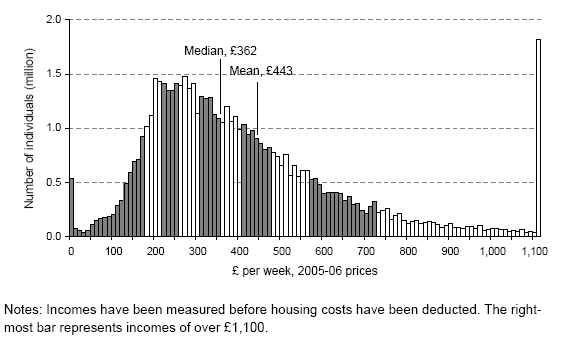
The above graph shows the UK income distribution in 2005–06. It maps out the number of people living in households with at various income tiers, grouped into £10 income bands. The height of the bars is representative of the number of people in each income band. The graph shows the currently distorted levels of income distribution as while 64% of individuals have household incomes below the national average, the last bar of the graph shows that 1.8 million individuals (out of a private household population of about 57 million individuals) have incomes above £1,100 per week. In addition, according to this graph, there are approximately half a million individuals whose income is between zero and £10 a week (Brewer, et al., 2007).
While the New Labour Government has managed to reduce rates of child and pensioner poverty in recent years, it is said that income inequality in Britain is currently at its highest level as compared to the past 20 years. Income distribution has become more than a little skewed with incomes at the top has risen rapidly while those at the bottom have grown much more slowly. This can be attributed to the probability of the demand for educated workers has exceeded its supply, as well as the high rates and amounts of executive pay increases (Chote, 2004).
It was found that within companies, executives were given increases of 23% or more in their annual salary. The lower-level staff, however, got less than 4% raises. Income gaps are so massive that in a typical situation, the chief executive of an FTSE 100 company earns, on an average basis, 80 times more than one of his workers. Wage inequalities have particularly seen a sharp increase, and wages for skilled and unskilled workers are highly disparate (“Rising Inequality in the UK.”).
There can be several reasons for this. Due to the increase in technology usage, there is a specific demand for certain skills and qualifications. Other than that, in recent times, trade unions have also played a lesser powerful role as compared to their previous participation power. Inequality has also risen because while the rate of male participation in the labor market has decreased, female participation has increased in households with other working partners. Hence, the two-earner and zero-earner households are drifting further apart on the scales of income inequality. The health and wealth divide is widening at an identical rate as official figures reflect widening gaps in pay, assets, and life expectancy. Possible reasons for wealth inequality can be growth in national output, higher entrepreneurial incomes, and the housing price boom (Carvel, 2004; “Income Inequality”).
Health inequalities are also increasing even though the government is making attempts to bridge this gap. On accounts of infant mortality and life expectancy, there is a huge difference between the poorest and the population as a whole. The health secretary himself has been quoted as saying that a man born in Manchester would on average die nine years sooner than a man in Kensington and China (“Johnson vows to narrow health inequalities”). This is primarily because the poor do not have access to primary care and treatment. Lack of provision of health care services is a primary concern as ethnic minority groups living in low-income and low-education areas have no access to medical facilities or general practitioners. A focus on prevention rather than treatment is also needed to educate the masses about the prevention of chronic diseases like cancer, diabetes, and heart problems (“Health Inequality Gap Widening.”).
References
Brewer, et al. Poverty and Inequality in the UK: 2007. The Institute of Fiscal Studies.
Carvel, John. “Super-rich have doubled their money under Labor.” Guardian Unlimited.
Chote, Robert. “The UK’s Wage Poverty Paradox.” BBC News.
“Health Inequality Gap Widening.” BBC News.
“Income Inequality.” National Statistics Online. 2007. Web.
“Johnson vows to narrow health inequalities”. Yahoo! News. 2007. Web.
“Rising Inequality in the UK.” Anarchism Website. 2007.